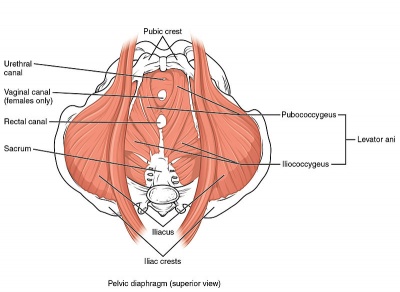Constipation: Difference between revisions
No edit summary |
No edit summary |
||
| Line 25: | Line 25: | ||
Irritable Bowel Syndrome | Irritable Bowel Syndrome | ||
Functional Outlet Disorder (known as dyssynergic defecation or pelvic floor dyssynergia) | Functional Outlet Disorder (known as dyssynergic defecation or pelvic floor dyssynergia)<ref name=":1">Rao SS, Valestin J, Brown CK, Zimmerman B, Schulze K. Long-term efficacy of biofeedback therapy for dyssynergic defecation: randomized controlled trial. The American journal of gastroenterology. 2010 Apr;105(4):890.</ref><ref name=":2">Chiarioni G, Whitehead WE, Pezza V, Morelli A, Bassotti G. Biofeedback is superior to laxatives for normal transit constipation due to pelvic floor dyssynergia. Gastroenterology. 2006 Mar 1;130(3):657-64.</ref><ref name=":3">Rao SS, Valestin JA, Xiang X, Hamdy S, Bradley CS, Zimmerman MB. Home-based versus office-based biofeedback therapy for constipation with dyssynergic defecation: a randomised controlled trial. The Lancet Gastroenterology & Hepatology. 2018 Nov 1;3(11):768-77.</ref> | ||
Diseases of the central and peripheral nervous systems, as they affect the colonic and anorectal motor functions | Diseases of the central and peripheral nervous systems, as they affect the colonic and anorectal motor functions | ||
| Line 58: | Line 58: | ||
Physiotherapist | Physiotherapist | ||
Biofeedback can be a very useful tool for patients | Biofeedback can be a very useful tool for patients<ref name=":1" /><ref name=":2" /><ref name=":3" /> | ||
Physician | Physician | ||
Revision as of 20:18, 19 March 2019
- Page is currently under construction, please check back soon for an updated page
Definition[edit | edit source]
Chronic constipation is infrequent bowel movements or difficult passage of stools that persists for several weeks or longer.[1]
Etiology[edit | edit source]
The prevalence of chronic constipation in North America 2% to 27%, the percentage varies because of the differing diagnostic criteria used.[2]
Secondary causes of constipation include:
Neurologic
Metabolic disorders
Obstructive lesions of the gastrointestinal tract, such as colorectal cancer
Endocrine disorders, such as diabetes mellitus
Psychiatric disorders such as anorexia nervosa
Aganglionosis (Hirschsprung disease)
Irritable Bowel Syndrome
Functional Outlet Disorder (known as dyssynergic defecation or pelvic floor dyssynergia)[3][4][5]
Diseases of the central and peripheral nervous systems, as they affect the colonic and anorectal motor functions
Side-effects of drugs
Clinically Relevant Anatomy[edit | edit source]
Please see the page "Pelvic Floor Anatomy," for further details regarding anatomy.
Clinical Presentation[edit | edit source]
An international working committee recommended the following diagnostic criteria (Rome IV) for functional constipation:[6]
- Must include two or more of the following:
- Straining during more than 25 percent of defecations.
- Lumpy or hard stools (Bristol Stool Scale Form 1-2) in more than 25 percent of defecations (figure 1).
- Sensation of incomplete evacuation for more than 25 percent of defecations.
- Sensation of anorectal obstruction/blockage for more than 25 percent of defecations.
- Manual maneuvers to facilitate more than 25 percent of defecations (eg, digital evacuation, support of the pelvic floor).
- Fewer than three spontaneous bowel movements per week.
2. Loose stools are rarely present without the use of laxatives
3. There are insufficient criteria for IBS. (See "Clinical manifestations and diagnosis of irritable bowel syndrome in adults".)
Although patients with functional constipation may have abdominal pain and/or bloating, they are not the predominant symptoms.
Management/Interventions[edit | edit source]
Education
Diet
Physiotherapist
Biofeedback can be a very useful tool for patients[3][4][5]
Physician
References[edit | edit source]
- ↑ Mayo Clinic. Constipation. Available from: https://www.mayoclinic.org/diseases-conditions/constipation/symptoms-causes/syc-20354253
- ↑ Suares NC, Ford AC. Prevalence of, and risk factors for, chronic idiopathic constipation in the community: systematic review and meta-analysis. The American journal of gastroenterology. 2011 Sep;106(9):1582.
- ↑ 3.0 3.1 Rao SS, Valestin J, Brown CK, Zimmerman B, Schulze K. Long-term efficacy of biofeedback therapy for dyssynergic defecation: randomized controlled trial. The American journal of gastroenterology. 2010 Apr;105(4):890.
- ↑ 4.0 4.1 Chiarioni G, Whitehead WE, Pezza V, Morelli A, Bassotti G. Biofeedback is superior to laxatives for normal transit constipation due to pelvic floor dyssynergia. Gastroenterology. 2006 Mar 1;130(3):657-64.
- ↑ 5.0 5.1 Rao SS, Valestin JA, Xiang X, Hamdy S, Bradley CS, Zimmerman MB. Home-based versus office-based biofeedback therapy for constipation with dyssynergic defecation: a randomised controlled trial. The Lancet Gastroenterology & Hepatology. 2018 Nov 1;3(11):768-77.
- ↑ Longstreth GF, Thompson WG, Chey WD, Houghton LA, Mearin F, Spiller RC. Functional bowel disorders. Gastroenterology. 2006 Apr 1;130(5):1480-91.







